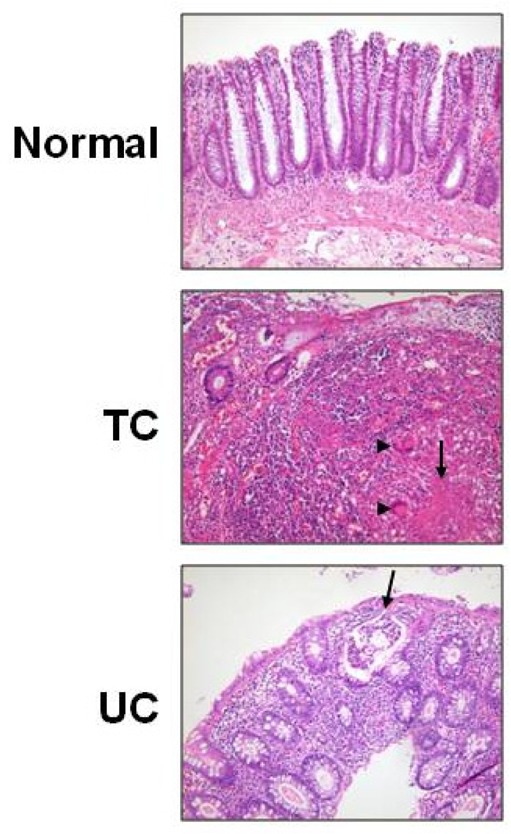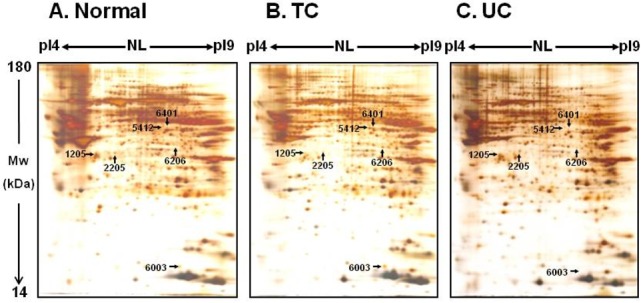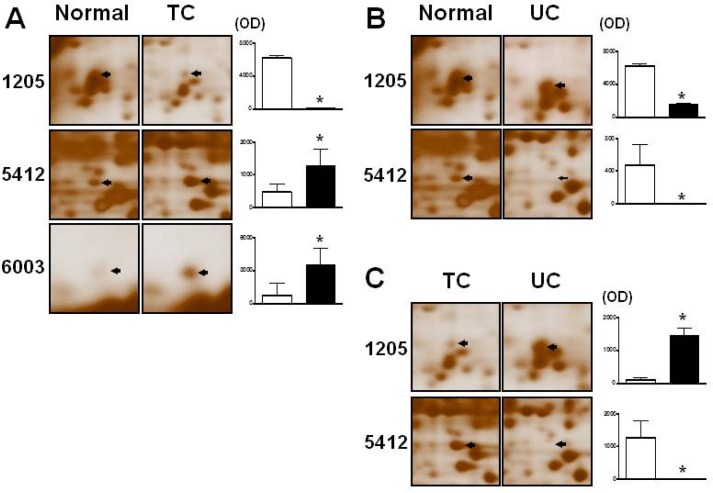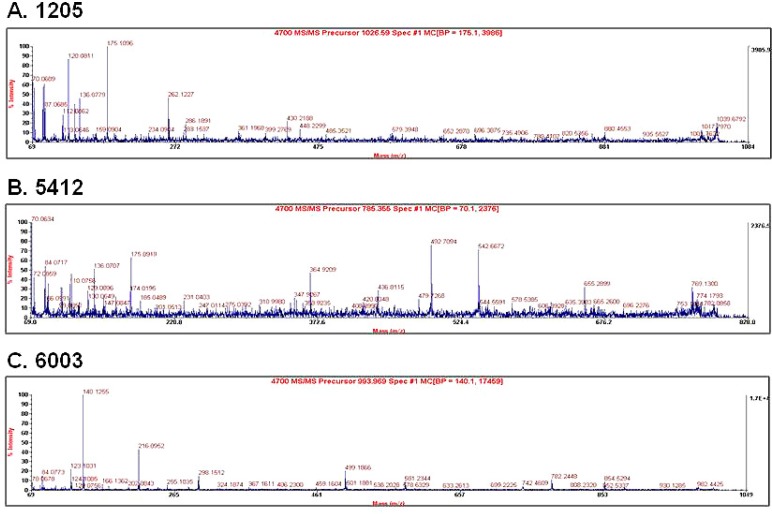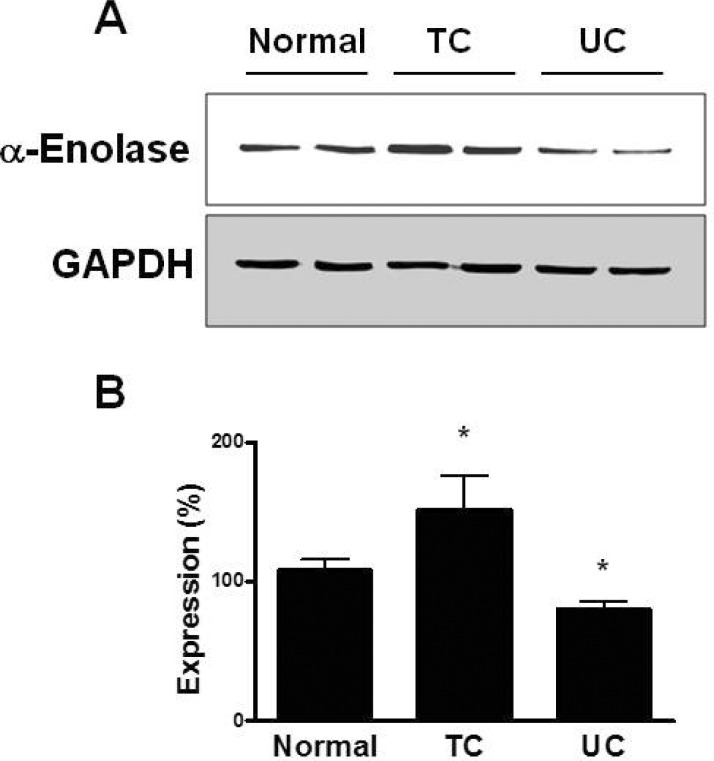1. Horn AE, Ufberg JW. Appendicitis, diverticulitis, and colitis. Emerg Med Clin North Am. 2011; 29:347–368. PMID:
21515183.

2. Rasheed S, Zinicola R, Watson D, Bajwa A, McDonald PJ. Intra-abdominal and gastrointestinal tuberculosis. Colorectal Dis. 2007; 9:773–783. PMID:
17868413.

3. Brenner SM, Annes G, Parker JG. Tuberculous colitis simulating nonspecific granulomatous disease of the colon. Am J Dig Dis. 1970; 15:85–92. PMID:
5410870.

4. Danese S, Fiocchi C. Ulcerative colitis. N Engl J Med. 2011; 365:1713–1725. PMID:
22047562.

5. Page MJ, Amess B, Rohlff C, Stubberfield C, Parekh R. Proteomics: a major new technology for the drug discovery process. Drug Discov Today. 1999; 4:55–62. PMID:
10234157.

6. Mayr U, Mayr M, Yin X, Begum S, Tarelli E, Wait R, Xu Q. Proteomic dataset of mouse aortic smooth muscle cells. Proteomics. 2005; 5:4546–4557. PMID:
16240290.

7. Pinet F, Poirier F, Fuchs S, Tharaux PL, Caron M, Corvol P, Michel JB, Joubert-Caron R. Troponin T as a marker of differentiation revealed by proteomic analysis in renal arterioles. FASEB J. 2004; 18:585–586. PMID:
14715693.

8. Won KJ, Lee P, Jung SH, Jiang X, Lee CK, Lin HY, Kang H, Lee HM, Kim J, Toyokuni S, Kim B. 3-morpholinosydnonimine participates in the attenuation of neointima formation via inhibition of annexin A2-mediated vascular smooth muscle cell migration. Proteomics. 2011; 11:193–201. PMID:
21204247.

9. Lee CK, Han JS, Won KJ, Jung SH, Park HJ, Lee HM, Kim J, Park YS, Kim HJ, Park PJ, Park TK, Kim B. Diminished expression of dihydropteridine reductase is a potent biomarker for hypertensive vessels. Proteomics. 2009; 9:4851–4858. PMID:
19743417.

10. Lee CK, Kim HJ, Lee YR, So HH, Park HJ, Won KJ, Park T, Lee KY, Lee HM, Kim B. Analysis of peroxiredoxin decreasing oxidative stress in hypertensive aortic smooth muscle. Biochim Biophys Acta. 2007; 1774:848–855. PMID:
17556052.

11. Hsieh SY, Shih TC, Yeh CY, Lin CJ, Chou YY, Lee YS. Comparative proteomic studies on the pathogenesis of human ulcerative colitis. Proteomics. 2006; 6:5322–5331. PMID:
16947118.

12. Shkoda A, Werner T, Daniel H, Gunckel M, Rogler G, Haller D. Differential protein expression profile in the intestinal epithelium from patients with inflammatory bowel disease. J Proteome Res. 2007; 6:1114–1125. PMID:
17330946.

13. Nagar AB. Isolated colonic ulcers: diagnosis and management. Curr Gastroenterol Rep. 2007; 9:422–428. PMID:
17991345.

14. Kühbacher T, Schreiber S, Fölsch UR. Ulcerative colitis: conservative management and long-term effects. Langenbecks Arch Surg. 2004; 389:350–653. PMID:
15133672.

15. Minami M, Hasegawa T, Ando T, Maeda O, Ohkura T, Ohta M, Goto H. Post-colonoscopic Listeria septicemia in ulcerative colitis during immunosuppressive therapy. Intern Med. 2007; 46:2023–2027. PMID:
18084128.

16. Schroeder KW, Tremaine WJ, Ilstrup DM. Coated oral 5-aminosalicylic acid therapy for mildly to moderately active ulcerative colitis. A randomized study. N Engl J Med. 1987; 317:1625–1629. PMID:
3317057.
17. Alvares JF, Devarbhavi H, Makhija P, Rao S, Kottoor R. Clinical, colonoscopic, and histological profile of colonic tuberculosis in a tertiary hospital. Endoscopy. 2005; 37:351–356. PMID:
15824946.

18. Kapoor VK. Abdominal tuberculosis. Postgrad Med J. 1998; 74:459–467. PMID:
9926119.

19. Vermeulen N, Arijs I, Joossens S, Vermeire S, Clerens S, Van den Bergh K, Michiels G, Arckens L, Schuit F, Van Lommel L, Rutgeerts P, Bossuyt X. Anti-alpha-enolase antibodies in patients with inflammatory Bowel disease. Clin Chem. 2008; 54:534–541. PMID:
18218721.
20. Zhao X, Kang B, Lu C, Liu S, Wang H, Yang X, Chen Y, Jiang B, Zhang J, Lu Y, Zhi F. Evaluation of p38 MAPK pathway as a molecular signature in ulcerative colitis. J Proteome Res. 2011; 10:2216–2225. PMID:
21428429.

21. Roozendaal C, Zhao MH, Horst G, Lockwood CM, Kleibeuker JH, Limburg PC, Nelis GF, Kallenberg CG. Catalase and alpha-enolase: two novel granulocyte autoantigens in inflammatory bowel disease (IBD). Clin Exp Immunol. 1998; 112:10–16. PMID:
9566783.
22. Royds JA, Timperley WR, Taylor CB. Levels of enolase and other enzymes in the cerebrospinal fluid as indices of pathological change. J Neurol Neurosurg Psychiatry. 1981; 44:1129–1135. PMID:
7334408.

23. Roine RO, Somer H, Kaste M, Viinikka L, Karonen SL. Neurological outcome after out-of-hospital cardiac arrest. Prediction by cerebrospinal fluid enzyme analysis. Arch Neurol. 1989; 46:753–756. PMID:
2742544.
24. Hay E, Royds JA, Davies-Jones GA, Lewtas NA, Timperley WR, Taylor CB. Cerebrospinal fluid enolase in stroke. J Neurol Neurosurg Psychiatry. 1984; 47:724–729. PMID:
6747647.

25. Grigoriadis G, Anderson MA, Whitehead S. Charcot-Leyden crystals. Intern Med J. 2010; 40:792. PMID:
21155159.
26. Di Sabatino A, Battista N, Biancheri P, Rapino C, Rovedatti L, Astarita G, Vanoli A, Dainese E, Guerci M, Piomelli D, Pender SL, MacDonald TT, Maccarrone M, Corazza GR. The endogenous cannabinoid system in the gut of patients with inflammatory bowel disease. Mucosal Immunol. 2011; 4:574–583. PMID:
21471961.

27. Ackerman SJ, Liu L, Kwatia MA, Savage MP, Leonidas DD, Swaminathan GJ, Acharya KR. Charcot-Leyden crystal protein (galectin-10) is not a dual function galectin with lysophospholipase activity but binds a lysophospholipase inhibitor in a novel structural fashion. J Biol Chem. 2002; 277:14859–14868. PMID:
11834744.

28. Lin TA, Kourteva G, Hilton H, Li H, Tare NS, Carvajal V, Hang JS, Wei X, Renzetti LM. The mRNA level of Charcot-Leyden crystal protein/galectin-10 is a marker for CRTH2 activation in human whole blood in vitro. Biomarkers. 2010; 15:646–654. PMID:
20858065.
29. Fujita M, Ichinose S, Kiyono T, Tsurumi T, Omori A. Establishment of latrunculin-A resistance in HeLa cells by expression of R183A D184A mutant beta-actin. Oncogene. 2003; 22:627–631. PMID:
12555075.
30. Nunoi H, Yamazaki T, Tsuchiya H, Kato S, Malech HL, Matsuda I, Kanegasaki S. A heterozygous mutation of beta-actin associated with neutrophil dysfunction and recurrent infection. Proc Natl Acad Sci USA. 1999; 96:8693–8698. PMID:
10411937.
31. Schevzov G, Lloyd C, Gunning P. High level expression of transfected beta- and gamma-actin genes differentially impacts on myoblast cytoarchitecture. J Cell Biol. 1992; 117:775–785. PMID:
1577857.

